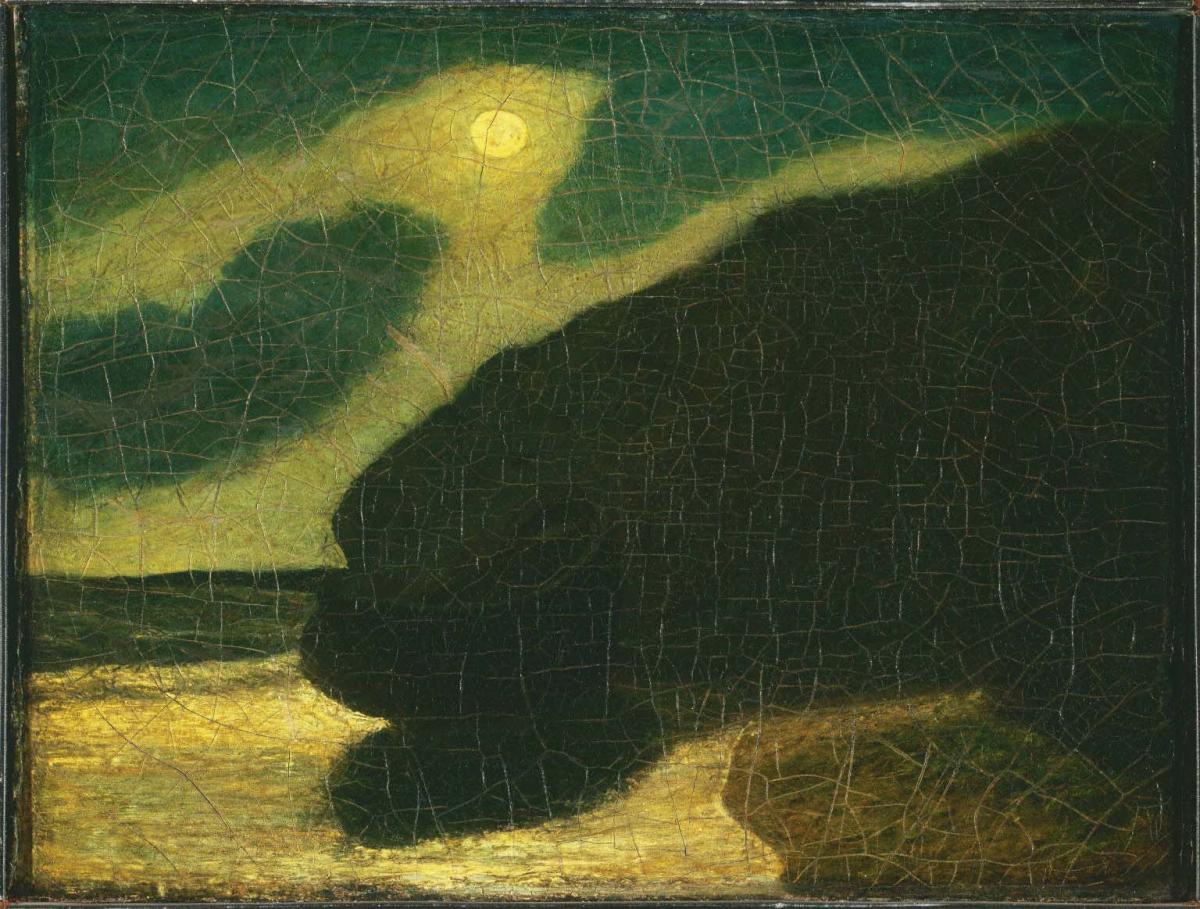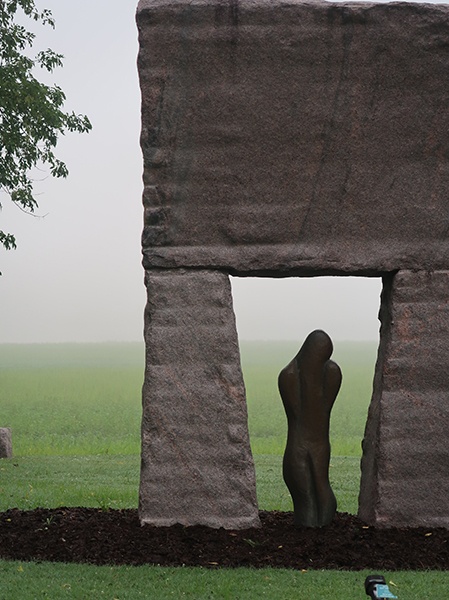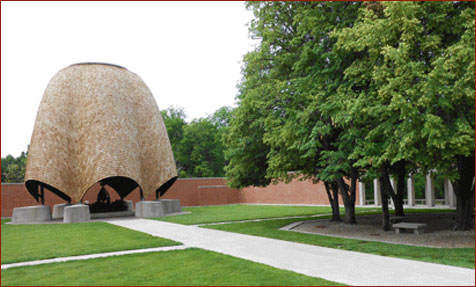Episode 11: Tobi Kahn
Release date: Jan. 20, 2015
Tobi Kahn is a New York-based painter, sculptor, and educator, who for thirty years has been steadfast in his commitment to the redemptive possibilities of art. MOCRA director Terrence Dempsey, S.J., spoke with Kahn about integrating faith and heritage with his artistic practice, his commissions for public sacred spaces, and how MOCRA has impacted his career.
Scroll down for a Listening Guide with more information about the topics discussed.
Related Episode
Episode 10: MOCRA Memories - The Early Years
Related Exhibitions
Tobi Kahn: Metamorphoses
Avoda: Objects of the Spirit
Credits
Producer: David Brinker
Recording Engineer and Editor: Mike Schrand
Host: Linda Kennedy
Theme and Incidental Music: Stephen James Neale
Listening Guide: David Brinker
Featured Guest

Tobi Kahn is a New York-based painter, sculptor, and educator, who for thirty years has been steadfast in his commitment to the redemptive possibilities of art. Kahn’s art is strongly influenced by his Jewish faith as well as by artists such as Albert Pinkham Ryder, Georgia O’Keeffe, Arthur Dove, and Mark Rothko. He was selected as one of nine artists included in the 1985 Guggenheim Museum exhibition, New Horizons in American Art. Since then his work has been shown in over 40 solo exhibitions and over 60 museum and group shows. His works are found in major museums, corporate, and private collections. He has also been commissioned to create contemplative sacred spaces. Kahn has taught on the faculty of the School of Visuals Arts in New York City since 1985.
MOCRA presented two major traveling exhibitions by Kahn. Metamorphoses included paintings evocative of landscapes and seascapes, and scientific imagery. The second exhibition, Avoda: Objects of the Spirit, presented Jewish ceremonial objects Kahn has created for family and friends.
Listening Guide
| 02:00 |
Learn more about Wolfgang Laib below, at 07:35. |
|||||
| 03:05 | Tobi Kahn’s work was included in a 1986 exhibition at in New York titled Jewish Themes: Contemporary American Artists Part II, curated by Susan Goodman. | |||||
| 04:40 | Learn more about . | |||||
| 05:05 |
The term “” refers to the inner sanctuary of the Jewish Temple in Jerusalem where the Ark of the Covenant was maintained. Read more in this Wikipedia article. The Jewish priesthood wore garments specific to their order, and the High Priest of Israel had , as described here. The , listed here, took their names from the sons of the patriarch Jacob. The Bible makes some references to standards or flags for the Twelve Tribes, and are found in midrashic sources. |
|||||
| 05:25 |
Kahn makes reference to the extravagant movie epics based (sometimes loosely) on Biblical stories produced by Hollywood in the 1950s and 1960s. One well-known example is the film (1956), starring Charleton Heston. The film’s depiction of the parting of the Red Sea was perhaps the most complex visual effect attempted up to that time. MOCRA’s 2007 exhibition The Celluloid Bible: Marketing Films Inspired by Scripture featured posters from many of these Biblical extravaganzas, along with other promotional materials as seen in this “Living St. Louis” segment: |
|||||
| 05:45 | Learn more about painters (1903–1970) and (1893–1943). | |||||
| 06:25 | The collects the teachings and opinions of generations of rabbis on a variety of subjects, including Jewish law and ethics, philosophy, customs, history, lore and much more. Learn more in this Wikipedia article. | |||||
| 06:40 |
(1847–1917) is known for his atmospheric, suggestive paintings. |
|||||
| 07:05 |
Kahn’s work was included in a 1999-2000 exhibition at the Albright-Knox Art Gallery in Buffalo, New York, titled Landscape at the Millennium, which paired nineteenth-century landscape paintings from the collections of the Albright-Knox Art Gallery and the Parrish Art Museum, Southampton, New York, with two contemporary installations by Kahn and painter Pat Steir. . Tobi Kahn: Sky & Water was shown at the Neuberger Museum of Art in Purchase, N.Y., in 2003. . |
|||||
| 07:35 |
Josef Albers (1888–1976) was an artist and an influential theorist and educator. He is particularly known for the Homages to the Square he painted between 1950 and 1976 and for his 1963 publication Interaction of Color. . (b. 1943) is an American artist primarily concerned with light and space. Among other works, he is known for his “skyscapes” and his ongoing project to transform the Roden Crater. (b. 1950) is a German artist whose work is often highly conceptual and employs predominantly natural, organic, ephemeral materials. . (b. 1939) is considered a pioneer of the “Light and Space” movement in Southern California in the 1960s and 1970s. |
|||||
| 08:15 |
See images of Kahn’s . Read about other sacred space projects by Kahn in this and this . |
|||||
| 09:05 | In the Bible, Chapter 31 of the book of Exodus recounts how God selects Bezalel as the architect of the , the portable dwelling place for the divine presence during the Israelites’ desert sojourn. to artists and architects today. | |||||
| 10:05 |
See above at 03:05 for a discussion of the Jewish Museum exhibition. Kahn’s work was included in a 1987 exhibition at the in Syracuse, NY, titled Sacred Spaces, curated by Dominique Nahas. . |
|||||
| 10:45 |
See above at 05:05 for a discussion of the Holy of Holies. |
|||||
| 12:20 |
Jane Blaffer Owen (1915–2010) dedicated much of her life to the small town of . Situated on the Wabash River, New Harmony was the site of two 19th-century utopian communities. Under Owen’s guidance and with her patronage, it also became home to a rich body of contemporary art and architecture by figures such as Richard Meier, Jacques Lipschitz, Philip Johnson, and Stephen DeStaebler—a collection now known as the . Read a . Kahn's 1993 sculpture Shalev is situated in New Harmony on the banks of the Wabash River. |
|||||
| 13:55 |
(1919–2019) was a renowned curator of contemporary art as well as a historian of German Expressionism. Selz became the curator of the department of painting and sculpture at the Museum of Modern Art, New York in 1958. In 1965 he was called to the University of California, Berkeley to found the university’s art museum. Selz served as its director from 1965 to 1973. He was known more recently for his provocative, politically charged exhibitions like The Art of Engagement, which showed at the American University Museum at the Katzen Arts Center in 2006. Selz curated both Tobi Kahn: Metamorphoses, shown at MOCRA in 1998, and the Patrick Graham retrospective The Silence Becomes the Painting, shown at MOCRA in 2012. Selz spoke at MOCRA twice, in 1995 on the topic of “Degenerate Art,” and in a 2012 panel discussion on the work of Patrick Graham, which you can watch here. Jane Daggett Dillenberger (1916–2014) was one of the pioneers in the dialogue between modern art and religion, beginning her work in the field of art history in 1942. As Professor Emerita in Art and Religion at the Graduate Theological Union, in Berkeley, California, she remained actively involved in the "religion and the arts" program at the Graduate Theological Union until her death. In addition to her teaching, she was a curator and a scholar. Her most important exhibitions were the 1972–1973 The Hand and the Spirit: Religious Art in America, 1700–1900, which she co-curated with art historian and museum director Joshua Taylor, and its sequel, Perceptions of the Spirit in 20th Century American Art, which she co-curated with her then-husband, theologian John Dillenberger. Her books include Image and Spirit in Sacred and Secular Art, Style and Content in Christian Art, and The Religious Art of Andy Warhol. Her final book, The Religious Art of Pablo Picasso, co-authored with art historian John Handley, was published in 2014. (Handley lectured on the book at MOCRA in 2014.) Dllenberger gave a keynote address at “The Artist and Sacred Space,” a 1992 conference marking MOCRA’s opening. She also appears in MOCRA Voices, Episode 6, discussing St. Peter's Lutheran Church in Manhattan. Fr. Dempsey discusses the significant roles Selz and Dillenberger played in the origins of MOCRA in MOCRA Voices, Episode 14: MOCRA Memories - Berkeley. |
|||||
| 16:30 |
(1901–1966) is best known as a sculptor, although he was a capable painter, printmaker and draughtsman as well. He was associated with the Surrealists in Paris in the 1930s, but his later work was influenced by Existentialist thought. (1898–1986) is best known for his semi-abstract monumental bronze sculptures, many displayed as public works of art. Like Giacometti, he is associated with representations of the human figure, but where Giacometti’s figures tend to be attenuated and spare, Moore’s are often undulating and even voluptuous. |
|||||
| 17:30 |
The is a structure in New Harmony designed by renowned architect Philip Johnson. The non-denominational church was commissioned by Jane Blaffer Owen and dedicated in 1960. Johnson and Owen envisioned a church where the only roof large enough to encompass a world of worshipers was the sky. |
|||||
| 20:45 |
Visit the . The Cornell Fine Arts Museum at Rollins College in Winter Park, Florida, presented in 2015. |
|||||
| 21:30 | Michael Brenson (b.1942) was an art critic for The New York Times from 1982 to 1991. Author of several books on art, he is a Getty scholar and Guggenheim
Fellow, a Visiting Senior Critic in the University of Pennsylvania School of Design's
Department of Fine Arts, and a member of the sculpture faculty in Bard College's Milton
Avery Graduate School of the Arts. He is also a faculty member at the School of Visual
Arts. Watch a 2012 talk by Brenson at the Ulrich Museum of Art in Wichita, KS:
(1871–1956), a major figure of the German Bauhaus, is renowned for his paintings of architecture and seascapes, but his work had a more whimsical dimension, including comic strips and miniature hand-carved wooden figures and buildings, known as City at the Edge of the World. Special calendars are used to count off the seven weeks of the Omer, the 49-day interval beginning on the second day of when an omer, or measure of barley, was offered at the Temple in Jerusalem—and ends on the day before , celebrating the giving of the Torah to the Israelites at Sinai. Symbolically, the time between the two holidays traces the path from physical freedom (the Exodus) to spiritual freedom (attained by the acceptance of the law). Kahn's Saphyr is a sculptural grid with 49 pegs conceived as miniature houses, each with a unique shape. , now in the collection of The Jewish Museum, New York. |
|||||
| 22:25 |
Nessa Rapoport is Senior Program Officer at the Charles H. Revson Foundation. Previously, she was a senior editor at Bantam Books, where she specialized in memoirs. Rapoport is the author of a novel, Preparing for Sabbath; a collection of prose poems, A Woman’s Book of Grieving; and a memoir, House on the River: A Summer Journey. Her essays and stories have been published in the New York Times, Los Angeles Times, and Forward and have been widely anthologized. Her column, “Inner Life,” appears in The Jewish Week. Rapoport writes and speaks frequently on Jewish culture and imagination and has collaborated on projects with her husband, Tobi Kahn. |
|||||
| 22:55 | Avoda: Objects of the Spirit was exhibited at MOCRA in 2003. Panelists for the conference “To Make Extraordinary: The Role of Sacred Objects in Life and Worship” included:
|
|||||
| 23:35 | at the Lawrence Family Jewish Center in La Jolla, CA. | |||||
| 25:35 | at the Kaplen Jewish Community Center on the Palisades in Tenafly, NJ. | |||||
| 26:05 |
in the sanctuary of Congregation Emanu-El B’ne Jeshrun in Milwaukee, WI. in the Elliot Binder Chapel of Temple Beth El of Northern Valley in Closter, NJ. |
|||||
| 26:40 |
See above at 08:15 for a discussion of Kahn’s installation at the HealthCare Chaplaincy in New York. Listen to a discussion of the Louise Nevelson Chapel of the Good Shepherd at St. Peter’s Lutheran Church in Manhattan in MOCRA Voices, Episode 6: Ralph Peterson and Jane Daggett Dillenberger. |
|||||
| 28:20 |
Artist is Founder and Executive Director of ; her husband, filmmaker , is Co-Founder and Creative Director. Jewish Art Now seeks to serve as “a central portal for the convergence of Judaism and contemporary art with a fresh and innovative perspective. . . . Jewish Art Now recharges Jewish identity and its relationship to the visual through engaging exhibitions, interactive events, and dynamic media content on the web.” Kahn refers to another initiative linking Judaism and contemporary art, the , which describes itself as “an international artist-driven community that promotes understanding and appreciation of contemporary and innovative Jewish visual art.” Its projects include exhibits, interactive art events, and bi-monthly salon sessions in the New York City area with international artists and scholars. Visit the Jewish Art Salon website. Artist is Executive Director of the Jewish Artists Salon. , currently President of Pardes Institute of Jewish Studies, was Shalom Hartman Institute of North America Vice President for Programs in Israel. He was also the founding director of the Skirball Center for Adult Jewish Learning at Temple Emanu-El in Manhattan. . |
|||||
| 29:40 |
Kahn’s family name derives from the Hebrew word for “priest,” kohen (כֹּהֵן). , as well as its place in the context of contemporary Judaism. Jewish worship is a richly layered tapestry of texts and practices, which cannot be done justice here. That being said, Kahn refers to , a series of blessings that are central to Jewish worship. , signifying worship, labor or service, is one of these blessings, and asks God to restore the Temple services and sacrificial services. To this day in many Jewish congregations, Kohanim impart the found in Numbers 6:23–27. |
|||||
| 29:55 |
See above at 22:55 for a discussion of the exhibition Avoda: Objects of the Spirit. has been curator of the Museum at Hebrew Union College - Jewish Institute of Religion since 1991. . |
|||||
| 31:45 |
(b. 1957) is an Iranian visual artist known primarily for her work in film, video and photography. Watch her TED Talk: (1908–1995) was an abstract expressionist painter who taught at the University of Wyoming, Pratt Institute, and the New York Studio School. in the Archives of American Art. |
|||||






